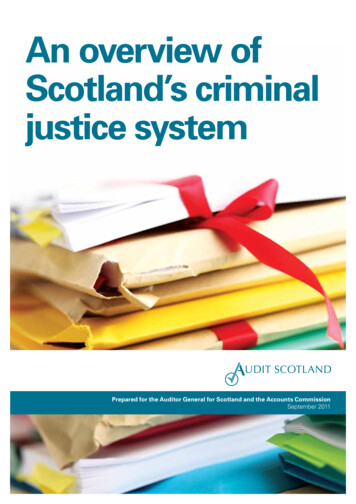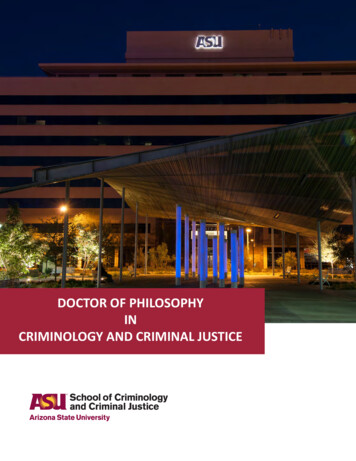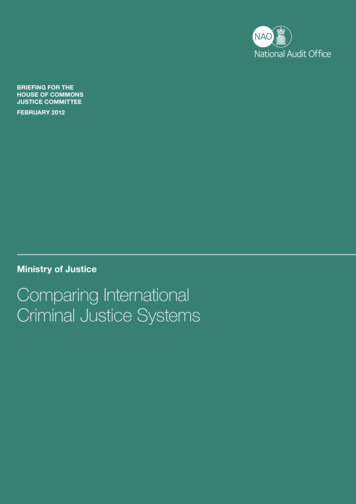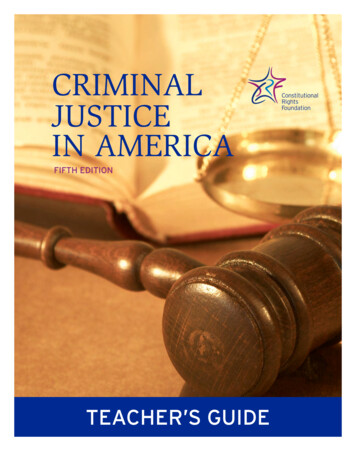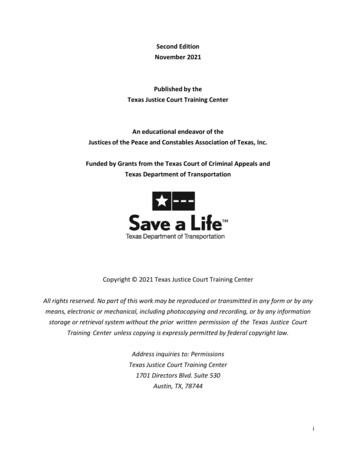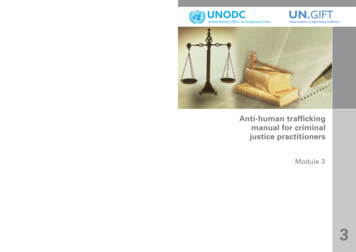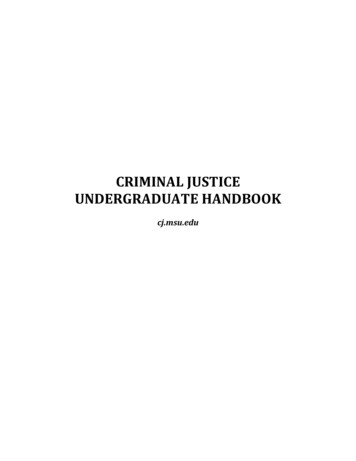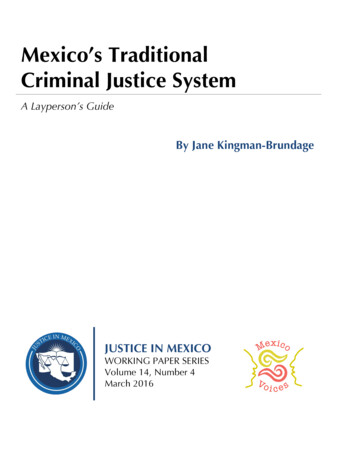
Transcription
Mexico’s TraditionalCriminal Justice SystemA Layperson’s GuideBy Jane Kingman-BrundageJUSTICE IN MEXICOWORKING PAPER SERIESVolume 14, Number 4March 2016
About Justice in Mexico:Started in 2001, Justice in Mexico (www.justiceinmexico.org) is a program dedicated to promoting analysis,informed public discourse, and policy decisions; and government, academic, and civic cooperation toimprove public security, rule of law, and human rights in Mexico. Justice in Mexico advances its missionthrough cutting-edge, policy-focused research; public education and outreach; and direct engagement withpolicy makers, experts, and stakeholders. The program is presently based at the Department of PoliticalScience and International Relations at the University of San Diego (USD), and involves university faculty,students, and volunteers from the United States and Mexico. From 2005 to 2013, the project was based atUSD’s Trans-Border Institute at the Joan B. Kroc School of Peace Studies, and from 2001 to 2005 it wasbased at the Center for U.S.-Mexican Studies at the University of California-San Diego.About this Publication:This paper introduces the legal logic underpinning Mexico’s traditional ‘mixed inquisitorial’ Criminal JusticeSystem in the tradition of Civil Law. The discussion begins by comparing salient characteristics of the CivilLaw and Common Law traditions. Three fundamental features alien to Common Law are identified:authoritarian nature, reliance on a deductive process anchored in both a Penal Code and a Code of CriminalProcedure, and a formal documentary focus. Mexico’s traditional Criminal Justice System is then examinedagainst this broad framework. A description of the Criminal Justice System’s structural components—including roles, responsibilities of various court officials—sets the stage for examining how the CriminalJustice System actually works—its four major procedural phases and the steps within those phases.About the Author:Jane Kingman-Brundage holds a MA in Psychology (Columbia U.) and Sociology (The New School). A 30year career in the Service Sector is distinguished by pioneering work in Service Mapping—a focusedflowcharting technique for diagnosing and finding solutions to service quality problems. Information andlogic taken from Service Maps was used to present technical information in language readily understandableby technical sales personnel and knowledgeable clients, who included the major money center banks (NewYork City), Xerox-Canada, Swedish National Railroad and a two-year project with Pemex, PetróleosMexicanos.In 2012 Jane began translating articles from the Mexican press for Mexico Voices founded by her husband,Reed. In the context of increasing violence arising from the Drug War, pieces involving the judicial systemstood out. Efforts to understand news reports of legal proceedings in the traditional (‘inquisitorial’) criminaljustice system led to development of this paper.Acknowledgements:The paper’s serendipitous origin deserves mention. The author happened to admit to a houseguest herinability to make sense of references in the Mexican press to Mexico’s criminal justice system. In response,the guest, retired Massachusetts State Court Judge R. Peter Anderson—who spent ten years bringing mocktrials to Chinese attorneys and judges to familiarize them with adversarial trials conducted in the tradition ofCommon Law—offhandedly remarked that the tradition of Civil Law predominates in a majority of theworld’s countries; whereas the Common Law tradition prevails only in the United Kingdom and in England’sformer colonies.Cultural assumptions thoroughly upended, nothing would do but track down what this meant in practicalterms. Thus began a four-year investigative adventure aided at every turn by Mexican and U.S. legalprofessionals. Every effort has been made to ensure the accuracy of the information presented here.
In the earliest stages of the research, Mexican lawyer Samantha Magdalena Toro Sánchez drew on herexperiences working in the court to adapt the traditional Federal Code of Criminal Procedures (CódigoFederal de Procedimientos Penales) into a Spanish this Anglo writer could understand, then patientlycorrected and expanded on early drafts in English. U.S. attorney Gregory K. Gomes reviewed a later version,his comments providing not just the much-needed U.S. legal perspective but reflected the discerning eye ofthe ‘first reader’ which greatly improved the readability of the procedural description. But the paper couldnot have achieved its stated goal of describing the judicial logic grounding Mexico’s traditional criminaljustice procedure without the keen insight of Mexico City attorney Edilberto López Martínez, who had thepatience to deal with difficult questions intended to tease out underlying juridical assumptions.The paper owes its final form to the critical review provided by a third Mexican lawyer, Octavio RodríguezFerreira, coordinator of the University of San Diego’s Justice in Mexico project, who saw the paper’spotential for explaining Mexico’s traditional Criminal Justice System to U.S. attorneys serving as trainers in acourse for Mexican lawyers designed to improve oral skills needed for success in the new ‘adversarial’system calling for cases to be argued before the Judge in open court.J. Reed Brundage merits special mention not just as founding editor and guiding spirit of Mexico Voices, butas the author’s understanding and ever-supportive husband across the decades.This is a joint publication by Justice in Mexico and Mexico Voices.Disclaimer: This paper was prepared by Jane Kingman-Brundage in her personal capacity. The opinionsexpressed in this article are the author's own and do not necessarily reflect the view of Justice in Mexico, theUniversity of San Diego, or any of its partner institutions. 2016 by Jane Kingman-Brundage.Justice in MexicoDepartment of Political Science & International RelationsUniversity of San Diego5998 Alcalá Park,San Diego, CA 92110
Mexico’s TraditionalCriminal Justice SystemJane Kingman-BrundageINTRODUCTIONGetting a handle on the logic of Mexico’s Criminal Justice Procedure poses a realchallenge for anyone unfamiliar with the tradition of Civil Law based on the NapoleonicCode—derived, in turn, from Roman law. The Civil Law tradition is significantly differentfrom the Common Law tradition that grew up in Britain and the English-speaking colonies,including the United States. Notably, Common Law is not the world’s dominant legalsystem. Below is a world map depicting the distribution of the world’s major legal systems(JuriGlobe—World Legal Systems Research Group, n.d.).FIGURE 1:SOURCE: JuriGlobe—World Legal Systems Research Group.At a fundamental level, the disparity between the traditions of Common Law and CivilLaw come down to whether the system is top-down or bottom-up. In “Inventing Freedom:How the English-Speaking Peoples Made the Modern World”, Daniel Hannan (2013, p.77) explains the difference:JUSTICE IN MEXICO1WORKING PAPER SERIES
Mexico’s Traditional Criminal Justice System“What distinguishes the common law from the Roman law that predominates in ContinentalEurope and its colonial offshoots? Chiefly this. The Continental legal model is deductive. A lawis written down from first principles, and then those principles are applied to a particular case.Common law, to the astonishment of those raised in the Roman or Napoleonic systems, doesthe reverse. It builds up, case by case, with each decision serving as the starting point for thenext dispute. It applies a doctrine known to lawyers as stare decisis: previous judgments shouldstand unaltered, serving as precedent. Common law is thus empirical rather than conceptual: itconcerns itself with actual judgments that have been handed down in real cases, then askswhether they need to be modified in the light of different circumstances in a new case.”Emphasis added.Rather than describing the Civil Law tradition as conceptual, we might prefer the termformal. As discussed later, the tradition of Civil Law adheres to first principles through theformal presentation of documents that conform to those principles. In Mexico’s federalcriminal law, these principles are organized in two codes: Federal Criminal Code [Código Penal Federal] (1931); and Federal Code of Criminal Procedures [Código Federal de Procedimientos Penales](1934).Each state also has its own codes of criminal law and criminal justice procedures.The goal here is to present the basics of the traditional Mexican Criminal Justice System,grounded in the tradition of Civil Law, in lay language to English-speaking readers. Thediscussion is presented in two parts: Part I: What the Criminal Justice System is, i.e., its Structure; and Part II: How the Criminal Justice System Works: Who, What, Why.Mexico’s traditional Criminal Justice System hews to the tradition of Civil Law. Simply put,the Public Prosecutor and Defense Attorney submit documents to the Judge, who isresponsible for assessing evidence represented in those documents and handing down aruling to dismiss, convict or acquit. It cannot be stated too strongly: in the Civil Lawtradition, for reasons to be discussed later, the paramount concern is ensuring thatdocuments conform to the letter of the law. In this sense, then, the Civil Law tradition isformal.The implications of this strict documentary focus are far-reaching. As will beshown, it affects everything from definition of the various stages in the judicial procedureto the organization of judicial support staff and their respective roles. These differences, attimes dramatic, are especially marked in the procedure for prosecuting criminal cases.Radical transformation of Mexico’s traditional, mixed inquisitorial1 criminal justicesystem is scheduled to be fully implemented by June 18, 2016, when the country’s newcriminal justice procedure based on oral (‘adversarial’) judicial proceedings is due to go1At the beginning of the 20th century, judicial reforms were passed (1934) that adopted some features of theadversarial system, giving rise to what is described as the ‘mixed inquisitorial’ system.2
Jane Kingman-Brundageinto effect. The reform law was passed in 2008, but implementation of the new system isproceeding slowly. Scholars and practitioners have taken advantage of this ongoingtransition to undertake an active assessment of the traditional (mixed inquisitorial) system.Judges and attorneys specializing in criminal defense and human rights have publishedinsightful critiques in the public press.2Thoughtful discussion of Mexico’s criminal justice system inevitably makesreference, directly or indirectly, to the sometimes considerable gap between the formalCriminal Justice Procedure and actual practice; i.e., how the criminal justice system reallyworks. A popular Mexican saying is apropos: “We treat the law with respect (i.e., we deferto the authority that concretely represents it), but we don’t comply with it.”In the report titled “In the Name of ‘War on Crime’: Analysis of the Phenomenon ofTorture in Mexico”, researched and published in 2012 by the French organizationChristian Action for the Abolition of Torture (ACAT, French acronym), the report’s author,Anne Boucher, writes of a gulf between the progressive set of human rights lawsbrandished (Boucher’s word) by Mexico’s government and the prevailing reality. In herreport, Boucher, head of ACAT’s Americas Department, trenchantly summarizes Mexico’scurrent Criminal Justice Procedure (cited in Mergier, 2012):“Completely written and secret, judicial proceedings are characterized by their slowness, bytheir bureaucratic nature, by their opacity, and especially by the unequal treatment afforded toprosecution and defense. Rather than favoring objective investigation of the facts, publicattorney and police are clearly seeking criminal prosecution and conviction, and that biastends to favor the practice of torture. Judges should be impartial a priori, but in many cases,their interventions support the prosecution. Even if not openly specified, the defendant actuallyappears ‘guilty until innocence is proved.’” Emphasis added.Law Professor Javier Dondé Matute (n.d.), School of Law, National AutonomousUniversity of Mexico, describes one significant anomaly:“In our traditional [mixed inquisitorial] system, the Public Ministry [charged with theprosecutorial and investigative functions] should establish a much broader threshold of proof[of guilt], but it is also endowed with public faith [fe pública], such that its actions are almostincontrovertible, or what is worse, it biases the burden of proof against the defendant, since itfalls to the defense team to rebut assertions of the Public Prosecutor compiled during thePreliminary Investigation. This violates the principle of presumption of innocence andconstitutes the Public Prosecutor as de facto presiding judge”. Emphasis added.Dondé Matute is not alone. Mexico’s internationally esteemed legal scholar, Miguel Sarre,corroborates his remarkable charge. In the article Mexico Criminal Justice Reform in FewWords, Sarre (2013) writes that the 2008 criminal justice reform provides2Mexico Voices has translated and posted many of these critiques. This paper draws on those sources andprovides links to the translation and to the original article in Spanish when available to non-subscribers.3
Mexico’s Traditional Criminal Justice System“ greater assurance of justice both for persons accused and for victims. To do this, the modeladopted strengthens the role of judges: all evidence will be presented in public trials in his orher presence. This will give more credibility to justice Procedural changes also aim tostrengthen the role of the defense, while the Public Ministry will lose the proceduraladvantages by which they are able to condition or determine the direction of the trial evenbefore it starts. Thus, the “preliminary” (or rather “final”) investigation is eliminated in whichprosecuting counsel seeks, clears and assesses means of evidence for itself and by itself;whereas, now [under the reform] the prosecutor will have to present its findings to the judge,subject both to the possibility of defense rebuttal and submitted for public scrutiny.” Emphasisadded.The constitutional judicial reform law went into effect on June 18, 2008. In recognition ofthe need for gradual implementation, the law mandates full implementation by June 18,2016. In 2006, however, some states began incorporating additional features of theadversarial system into their own judicial systems. The 2008 judicial reform legislationwas developed, in part, by drawing on the experiences of those states.Once the 2008 reform law went into effect, other states began implementingimmediately, such that today four states (Chihuahua, Morelos, State of México andYucatán) are classified as ‘fully operational’. At the other end, implementation isreportedly seriously lagging in three states (Michoacán, Baja California Sur and Sonora).Implementation in the remaining twenty-five states is classified as ‘partially operational’.Notably, under the traditional mixed inquisitorial system the courts are located insideprison facilities; thus, a key component for implementing the accusatorial system isconstruction of courthouses, termed ‘infrastructure’ in the following comment (Martínez,2015a):“Implementation of the new criminal justice system will be gradual. Although the lawanticipates that it should be in effect throughout the country by June 18, 2016, the ‘ideal’infrastructure will be completely ready within a decade. “The commitment by the federal authority to the June 2016 legal deadline is to have in placethe ‘basic infrastructure’ for the operation of oral [adversarial] trials .”Former public prosecutor Alicia Beatriz Azzolini (cited in Sánchez, 2015) recentlycommented:“The worst that could happen is that if the model doesn’t work well, they’ll say ‘it doesn’twork, it failed,’ and then we would remain with the old [mixed inquisitorial system] that wehad. That would be very serious.”A basic understanding of the traditional mixed inquisitorial system thus improves theability to make sense of whatever takes place in Mexico’s criminal justice system not justin 2016, but also in the years to come. It is worth noting that Mexico is joining other LatinAmerican countries engaged in moving toward an accusatorial criminal justice system;namely, Argentina (1991), Bolivia (2001), Colombia (2005), Costa Rica (1998), Chile(2000), Ecuador (2001), El Salvador (1998), Guatemala (1994), Honduras (2002),Nicaragua (2001), Paraguay (2000), Peru (2006), Dominican Republic (2004) and4
Jane Kingman-BrundageVenezuela (1999) (Análisis Comparado del Sistema de Justicia Penal de México conAmérica Latina , n.d.).Our goal here is to explain Mexico’s Criminal Justice System on its own terms,which is optimally achieved by describing its underlying, internal logic. This descriptionis the result, first, of independent research conducted by consulting publicly available(often online) Spanish language documents, including Government, sources. The selectfew documents in English are by attorneys credentialed both in Mexico and the UnitedStates.Finally, careful attention has been paid to translating Mexican legal terms from theSpanish in ways that elucidate for English-speaking readers the sometimes subtle meaningsinherent in terminology associated with the tradition of Civil Law. Hence, we aresensitive to translations of legal terms in standard dictionaries, which often seem subtlybiased in favor of the Common Law framework. Three examples immediately come tomind. Juicio is often translated into English as trial, but the translation is misleading, sinceto the Anglophone reader steeped in the Common Law tradition, it suggests a processwhere cases are argued in open court, with witnesses testifying and undergoing crossexamination. Since this is not the case in the inquisitorial system based on the Civil Lawtradition, we use the term judicial procedure or judicial proceeding.Facing the same cultural challenge, the verb declarar and the noun declaración areoften respectively translated as to testify and statement or testimony. In the legal context,however, these terms are more precisely understood as meaning to make a formal, legalstatement before prosecutorial officials. Transcribed by clerks, the statement is presentedto be signed by the person who made it. This signed formal statement becomes part of theexpediente, which brings us to the third example. Often translated as record, theexpediente is the formal, legal case file containing all documents and exhibits pertainingto a given case. As discussed later, this file can run to five hundred or even a thousand ormore pages.We turn now to consider Mexico’s traditional ‘mixed inquisitorial’ Criminal Justicesystem.PART I: WHAT THE CRIMINAL JUSTICE SYSTEM ISUnderstanding how the criminal justice procedure works is facilitated by familiarity withthe procedure’s major structural components and roles performed by key actors.OverviewOne Mexican source is the 83-page booklet titled, “What is the Judicial Authority of theFederation?” (¿Qué es el Poder Judicial de la Federación?).3 The Introduction to the FourthEdition states:3First published in 1999 by Mexico’s Supreme Court of the Nation (SCJN).5
Mexico’s Traditional Criminal Justice System“The Supreme Court, aware of the importance of civil society being familiar with thefunctioning of the Judicial Authority, has decided to publish, for the fourth time, this work whose acceptance by the legal profession and the general public has been evident sinceits initial publication in 1999.“The widespread acceptance of this work is due to the simplicity of its descriptions of thecomprehensive agencies of the Judicial Authority and to its educational qualities .”(SCJN, 2005, pp. 15-16).The constitutional reform for the 'adversarial' judicial system was not adopted until 2008,but starting in 2006 a few states began anticipating that reform by implementing their ownversions. Thus, the description of the structure and functions of the Federal Judiciary setforth in the 2005 booklet is a valuable source of information on the traditional, ‘mixedinquisitorial’ system. When cited here, the abbreviation SCJN is used.The fundamental structure of Mexico’s legal system is laid out clearly andsuccinctly in the opening paragraphs. In short, the: Federal Constitution is the Supreme Law of the Mexican Union; it is divided intotwo parts: dogmatic and organic; the Constitution’s dogmatic part assembles the individual rights, i.e., guaranteesgranted to individuals, that must be respected by the State; the Constitution’s organic part organizes public authorities to prevent abuse of power;the Federal Constitution created the Judicial Authority and charged it with defendingconstitutional order, which is guaranteed by the amparo (SCJN, 2005, pp. 17-19).Procedurally, the amparo arises in connection with the process of reviewing any courtorder, ruling or resolution, up to and including the court’s Final Resolution (i.e., of guilt orinnocence) that concludes a criminal procedure. It is, however, appropriate to introduceamparo here as a legal concept precisely because of its crucial role in the logic supportingthe entire criminal justice procedure. Amparo4 is defined as:“ the means of protection par excellence of individual rights established in ourConstitution. Through this [amparo], we can protect ourselves from laws or acts of theauthorities that violate our individual rights” (SCJN, 2005, p. 39).Another essential component of the criminal justice system is the juicio, judicialprocedure:“The juicio is the set of actions carried out before an agency of the State, namely a court, inorder that this court, based on proven facts and through application of the law, mightresolve a conflict or dispute arising between two or more subjects with opposing interests”(SCJN, 2005, p. 29).4Amparo is discussed in Part II when it arises in connection with the process of review contesting theJudge’s Final Resolution in a criminal case.6
Jane Kingman-BrundageIn accordance with the documentary nature of the civil law tradition, the stated ‘set ofactions’ is a series of documents formally submitted by the Public Ministry (performing itsprosecutorial function) and Defense Attorney to the court. To be clear, the term‘documents’ also covers such items as charts, maps, photographs, videography, etc.The court responds to documents submitted: First, by reviewing them to assure their conformity with legal requirements;underscoring the significance of this point, a Mexican attorney observed, “Evenmany Mexicans do not understand the importance of submitting documents thatstrictly conform to the law”; and Second, by issuing a series of judicial orders that are, of course, also documents;these judicial orders conclude with the Final Resolution, or ruling, of guilt orinnocence in criminal cases.Finally, two additional legal concepts are key for understanding the basics of thetraditional Criminal Justice System. Mexican lawyers will explain that there is historicaltruth, legal truth and what actually happened. Two case studies (see text boxes) illustratethe tension between the legal concepts and scientific forensic and standard crimeinvestigation procedures.Historical TruthThe Public Ministry is responsible for performing prosecutorial and investigative functionswithin the Office of the Attorney General. When its findings are issued at the conclusionof its Preliminary Investigation, these findings become the historical truth in the case.Reflecting on the current transition from the traditional ‘mixed inquisitorial’ to thecoming ‘adversarial’ criminal justice system, Mario Alberto Martínez Pérez (n.d.), a Judgein Oral Proceedings at the Superior Court in the State of Oaxaca, observes that thetraditional mixed inquisitorial criminal procedure considered that the primary purpose ofthe criminal justice process was to obtain the historical truth of the events reported as acrime, and it considered other values and interests to be subordinate to the goal ofobtaining absolute truth, which is by its nature historical. Remarkably, Judge MartínezPérez adds that within the traditional mixed inquisitorial criminal justice system, thisintention has served to justify the violation of fundamental rights without taking intoaccount the power of the State.The high-profile case of the enforced disappearance of 43 Ayotzinapa RuralNormal School (Teachers College) students in the municipality of Iguala, Guerrero, in2014 is a case in point.7
Mexico’s Traditional Criminal Justice SystemCASE STUDY 1: 43 AYOTZINAPA STUDENTS DISAPPEAREDWhat actually happened in Iguala, Guerrero, the night of September 26,2014, remains murky. What is known is that 43 students disappeared; they havenot been found. The government has announced the arrest of 104 people,including 64 municipal police and 40 presumed members of the Warriors Unitedcartel operating in the region. Iguala’s former mayor is in prison facing charges ofhaving masterminded the disappearance; the mayor’s wife is charged with linksto organized crime.Amidst unrelenting Mexican and international media attention and thetireless activism of the disappeared students’ parents, then Attorney General JesúsMurillo Karam (cited in Castillo García, 2015) held a press conference in January2015 during which he asserted that the ‘historical truth’ of what happened in theso-called Iguala case is already known—namely, that the bodies wereincinerated at the Cocula garbage dump; the remains were thrown into the SanJuan River. Thus, he said, the case should be ‘closed’. Murillo Karam alsoconfirmed that, according to expert opinions, evidence and detainee statements,the 43 students from Raúl Isidro Burgos Rural Normal School of Ayotzinapa werekilled and incinerated by members of the Warriors United cartel.The Attorney General thus attempted to close the case despite seriousquestions raised by the Argentine Forensic Anthropology Team (EAAF) about theforensic evidence—e.g., the EAAF cannot confirm the chain of custody of thehuman remains and has criticized the government for failing to secure theCocula garbage dump (Turati, 2015b). Additionally, the Interdisciplinary Groupof Independent Experts (IGIE) from the Inter-American Commission on HumanRights is also seeking, so far without success, to interview military personnel onduty that night in order to assess the military’s role in the events.Apparently, the former Attorney General’s attempt to impose ‘historical truth’has not yet succeeded. In a meeting with victims’ parents in July 2015, currentAttorney General, Arely Gómez Gónzalez, stated that the case remains open,and new investigative lines are being pursued (cited in Díaz, 2015). The case isongoing.Legal TruthWhen a First-Level Court Judge issues the Final Resolution (Resolución definitiva)establishing the guilt or innocence of the Accused, that resolution and the entire legal fileon which it is based become the legal truth in the case; as such, the case cannot berevisited in light of subsequent findings. This legal concept is amply illustrated in anotherhigh-profile case: Alberto Patishtán, indigenous Tzotzil from Chiapas.8
Jane Kingman-BrundageCASE STUDY 2: ALBERTO PATISHTÁNAlberto Patishtán, indigenous Tzotzil from the municipality of El Bosque,Chiapas, was a long-time bilingual (Tzotzil, Spanish) teacher known for hisactivism (Mandujano, 2013).The three weeks before the July 2, 2000, presidential election—in which thePRI [Revolutionary Institutional Party] would lose both the presidency (ending its70-year hold on power) and the governorship of Chiapas—were tumultuous. Inthe course of this campaign, Patishtán accused El Bosque’s mayor, ManuelGómez Ruiz, of corruption.On the morning of June 12, 2000, a group of nine officials heading to ElBosque were ambushed in a nearby hamlet. Seven were killed. The van’s driver,Rosemberg Gómez Pérez—son of Mayor Gómez Ruiz—was one of only twosurvivors.On June 19, 2000, State Police—acting without an arrest warrant—detainedAlberto Patishtán. The Chiapas government charged him with organized crime,homicide, possession of weapons for exclusive Army use and aggravated assault.Much later, Patishtán would comment that his biggest mistake wasantagonizing PRI Mayor Manuel Gómez Ruiz, whose son provided theeyewitness testimony on which the judge would base his Final Resolution ofguilt. Patishtán has said that he suffered violation of his individual rights,including physical and psychological torture, from the first moment of his arrest.Many witnesses testified that on the day of the ambush, Patishtán wasteaching his classes at the town’s elementary school. The judge, however,accepted as damning the sole testimony provided by the Mayor’s son—despiteevidence presented by the defense that the testimony was possibly ‘induced’,i.e., the witness lied; and by circumstantial evidence indicating ‘irregularities’ inhow the testimony was obtained. The judge also rejected the exculpatoryevidence presented by the defense on the unsubstantiated grounds that it was‘instructed’.Ultimately, the judge ruled that Patishtán was guilty and sentenced him to 60years in prison. This Final Resolution of guilt, together with the entire case file(expediente), thus became the ‘legal truth’, which meant that evidence compiledin the case file could not be revisited in light of subsequent findings.Patishtán spent thirteen years in prison before Alberto Leonel Rivero, attorneywith the Office for Strategic Defense of Human Rights, AC, succeeded inarranging for the case to be reviewed by the Supreme Court. On March 6, 2012,by a vote of 3-2, the Justices turned down the request and sent the case to theCollegiate Circuit [Appeals] Court in Tuxtla-Gutiérrez, Chiapas.Interviewed abo
Thoughtful discussion of Mexico's criminal justice system inevitably makes reference, directly or indirectly, to the sometimes considerable gap between the formal Criminal Justice Procedure and actual practice; i.e., how the criminal justice system really works. A popular Mexican saying is apropos: "We treat the law with respect (i.e., we defer
